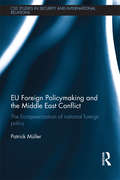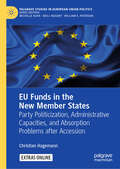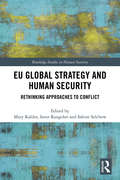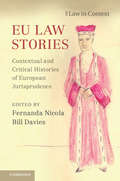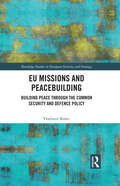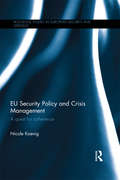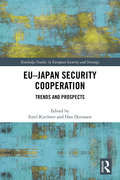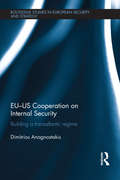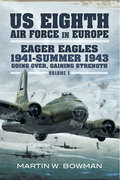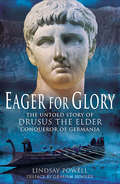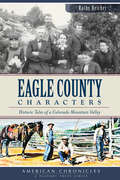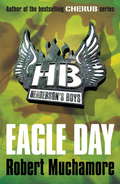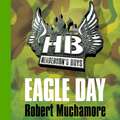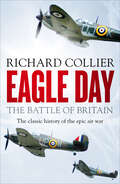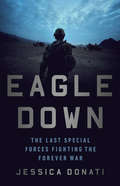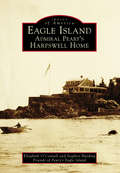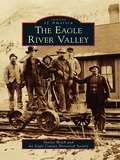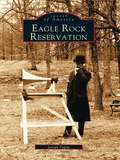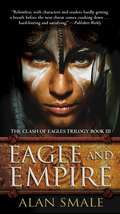- Table View
- List View
EU Foreign Policymaking and the Middle East Conflict: The Europeanization of national foreign policy (CSS Studies in Security and International Relations)
by Patrick MüllerThis book examines the interplay between the national and the European levels in EU foreign policymaking, focusing on the Middle East. European engagement in peacemaking in the Middle East dates back to foreign-policy cooperation in the early 1970s. Following the launch of the peace process in 1991, the EU and its Member States further stepped up their involvement in conflict resolution, focusing on one central area of EU engagement – the Israeli-Palestinian conflict. This book covers the period from the beginning of the peace process in 1991 until 2008, and focuses on the actions of the big three Member States: Germany, France and the UK. Using the Europeanization concept as framework of analysis, the book examines the problematic dynamics between these Member States’ national foreign-policy models and the construction of a common European conflict-resolution policy. It also provides interesting new insights into the EU’s international role and potential, addressing the often neglected question of how Europeanization effects help to mitigate some of the classical limitations of European foreign policymaking. The book will be of great interest to students of EU policy, Middle Eastern Politics, peace and conflict resolution, security studies and IR.
EU Funds in the New Member States: Party Politicization, Administrative Capacities, And Absorption Problems After Accession (Palgrave Studies in European Union Politics)
by Christian HagemannThis book examines new member states’ problems with the absorption of EU funds. Since accession, many new member states from Central and Eastern Europe struggle to access their billions of development funds from Brussels. While existing research mostly emphasizes the role of states’ administrative capacities to account for absorption problems, this study adds the so far neglected role of politics as party politicization to the equation. The argument is tested using a combination of fuzzy-set Qualitative Comparative Analysis (fsQCA) with two detailed process tracing case studies. This book will appeal to scholars interested in EU cohesion policy, post-accession compliance, and post-communist politics.
EU Global Strategy and Human Security: Rethinking Approaches to Conflict (Routledge Studies in Human Security)
by Mary Kaldor Iavor Rangelov Sabine SelchowThis volume examines the EU’s Global Strategy in relation to human security approaches to conflict. Contemporary conflicts are best understood as a social condition in which armed groups mobilise sectarian and fundamentalist sentiments and construct a predatory economy through which they enrich themselves at the expense of ordinary citizens. This volume provides a timely contribution to debates over the role of the EU on the global stage and its contribution to peace and security, at a time when these discussions are reinvigorated by the adoption of the EU Global Strategy. It discusses the significance of the Strategic Review and the Global Strategy for the re-articulation of EU conflict prevention, crisis management, peacebuilding, and development policies in the next few years. It also addresses the key issues facing EU security in the 21st century, including the conflicts in Ukraine, Libya and Syria, border security, cyber-security and the role of the private security sector. The book concludes by proposing that the EU adopts a second-generation human security approach to conflicts, as an alternative to geopolitics or the ‘War on Terror’, taking forward the principles of human security and adapting them to 21st-century realities. This book will be of interest to students of human security, European foreign and security policy, peace and conflict studies, global governance and IR in general.
EU Law Stories: Contextual and Critical Histories of European Jurisprudence (Law in Context)
by Bill Davies Fernanda NicolaThrough an interdisciplinary analysis of the rulings of the Court of Justice of the European Union, this book offers 'thick' descriptions, contextual histories and critical narratives engaging with leading or minor personalities involved behind the scenes of each case. The contributions depart from the notion that EU law and its history should be narrated in a linear and incremental way to show instead that law evolves in a contingent and not determinate manner. The book shows that the effects of judge-made law remain relatively indeterminate and each case can be retold through different contextual narratives, and shows the commitment of the European legal elites to the experience of legal reasoning. The idea to cluster the stories around prominent cases is not to be fully comprehensive, but to re-focus the scholarship and teaching of EU law by moving beyond the black letter and unravel the lawyering techniques to achieve policy results. Revealing context and stories behind leading European Court of Justice rulings, the book will appeal to students interested in understanding the making and the functioning of EU law through the eyes of many interlocutors of the Court, including winners and losers in each case. Retells stories by leading scholars or participants in the cases from a different perspective, and so the book reveals new insights, including lawyering techniques together with social and political contexts, into the established canon of EU law. By bringing together lawyers, historians, political scientists and political economists, the volume achieves original cross-disciplinary insights into the field of EU law.
EU Missions and Peacebuilding: Building Peace through the Common Security and Defence Policy (Routledge Studies in European Security and Strategy)
by Vladimir KmecThis book analyses the European Union’s (EU) approach to peacebuilding in its Common Security and Defence Policy (CSDP) missions, and explores how this approach impacts the EU’s role in international conflict management. Peacebuilding carried out through CSDP instruments has become central to the self-conception of the EU as an actor in international conflict management. EU missions and operations have, for the most part, been deployed to promote peacebuilding efforts in post-conflict situations, in particular through capacity-building, reforms and rebuilding of state structures. This book focuses explicitly on the peacebuilding dimension of the CSDP while exploring why and how the EU has adopted peacebuilding in its CSDP actions as a norm and a practice. It analyses how peacebuilding in EU missions is conceptualised, designed, governed and implemented. The book examines the extent to which EU missions and operations reflect a normative and practical commitment of the EU to peacebuilding – that is to say, the extent to which CSDP instruments have been shaped by international peacebuilding norms and EU foreign policy. Drawing on empirical insights from decision- and policymaking processes in Brussels as well as from missions in Mali and in Bosnia and Herzegovina, this book offers critical perspectives on the EU’s role as an international peacebuilding actor. This book will be of much interest to students of European security, EU policy, peace and conflict studies, security studies and international relations.
EU Railway Policy-Making
by Helene DyrhaugeThe railways have a long tradition in Europe and the impact that they have on history is as much political as it is social or economic. National governments have traditionally had an active interest in the railways and indeed railways have become synonymous with ideas of state building and intervention. Similarly, on the supra-national level, the EU Commission sees the railways as central to the EU Transport Policy, the Single Market and Sustainable Development. It is perhaps strange then that the creation of an EU Railway Policy has been slow in the making. This book focuses on the role of the Commission in opening national railway markets and creating an EU governance structure for the railways. Indeed, the railway policy discussions and preferences are shaped by the fundamental question of whether the railways are a public service or an economic sector. The book argues that the Commission is constrained by the member states' resistance towards market opening as evident in the implementation process and demonstrates that the Commission's long term commitment has been able to advance its preferred governance system.
EU Security Policy and Crisis Management: A Quest for Coherence (Routledge Studies in European Security and Strategy)
by Nicole KoenigThis book explores European Union crisis management and draws implications for its role as an international security actor. The success of EU crisis management has varied greatly and this book aims to identify the key factors that explain the differing degrees of coherence through a comparative analysis of its multidimensional crisis responses in Africa. The empirical focus lies on three prominent EU crisis management cases, namely Libya in 2011, Somalia in 2011-2012, and the Sahel in 2012-2013. It analyses the activities and interaction of EU institutional actors and member states, with a focus on France, the United Kingdom, and Germany. The book argues that the EU represents a rather unpredictable security actor, whose multi-level coherence is contingent on the congruence of domestic economic and electoral interests, as well as national threat perceptions, and the extent to which EU-level coherence norms resonate with national norms on the use of force and modes of multilateral cooperation. In sum, this book offers systematic insight into EU crisis management and clarifies the conceptual and empirical boundaries of the comprehensive approach. Finally, the study of the micro-foundations of coherence allows for policy-relevant suggestions on the EU’s future role as a security actor. This book will be of much interest to students of EU policy, European Security, Peace and Conflict Studies, African Politics and IR in general.
EU Security Strategies: Extending the EU System of Security Governance (Routledge Studies in European Security and Strategy)
by Spyros Economides James SperlingThis volume offers a coherent analysis of the European Union’s security strategies within a comparative framework. If the EU is to survive and prosper as an effective security actor, it requires that greater attention be devoted to taking a cohesive and common position on the relationship between EU foreign policy means and goals. The major claim of this edited collection is that there is a European grand security strategy that disciplines member state security strategies. That grand strategy has two distinct substantive goals: (1) the preservation and expansion of the EU system of security governance; and (2) the implementation of specific strategies to meet internal and external threats and sources of insecurity. The EU has sought to develop a grand security strategy that not only accounts for the proliferation of threats possessing a military or non-military character and differentiates between core and peripheral regions of interest, but also addresses the requirements to bridge the increasingly blurred boundary between internal and external security threats and the necessary reconciliation of the competing security preferences of its member states. The empirical contributions to this volume examine the EU security strategies for specific issue areas and regional threat complexes. These case studies assess whether and how those strategies have consolidated or expanded the EU system of security governance, as well as their successes and limitations in meeting the security threats confronting the EU and its member-states. This volume will be of great interest to students of EU policy, foreign policy, security studies and IR.
EU-Japan Security Cooperation: Trends and Prospects (Routledge Studies in European Security and Strategy)
by Han Dorussen Emil J. KirchnerThis book assesses EU-Japan security relations, examining how they have developed in individual security sectors and how they could be affected by international developments. The conclusions of the Economic Partnership Agreement and the Strategic Partnership Agreement in 2017 demonstrate the steady growth in EU-Japan political relations. Since the 1990s, dialogues between the EU and Japan have benefitted from extensive trade and investment ties and shared liberal values. Based on collaborative research by European and Japanese scholars, this book provides an in-depth, systematic and comparative analysis of the extent to which the EU and Japan have achieved concrete actions in the pursuance of security cooperation across a range of key areas such as nuclear proliferation, regional security, international terrorism, and energy and climate security. Further, it seeks to explain why some security sectors (such as economic and cybersecurity) have resulted in more extensive EU-Japan cooperation, while others lag behind (such as military and regional security). Common declarations and actions of shared interest and concerns have often led to only modest levels of security collaboration, and the book highlights factors that may be seen as intervening between intention and action, such as the role of external actors, for instance China and the US, and the constraints of internal EU and domestic Japanese politics. This book will be of much interest to students of European security, Japanese politics, diplomacy studies and international relations.
EU-US Cooperation on Internal Security: Building a Transatlantic Regime (Routledge Studies in European Security and Strategy)
by Dimitrios AnagnostakisThis book analyses the cooperation between the European Union and the United States on internal security and counter-terrorism since the 9/11 terrorist attacks. In particular, four areas of cooperation are examined: customs and supply chain security; judicial cooperation (the mutual legal assistance and extradition agreements); law enforcement cooperation (the Europol-US agreements); and the EU-US agreements for the sharing of air passengers’ data (PNR agreements). These cases are analysed through a conceptual framework based on the theories of international regimes, with the data being drawn from an extensive documentary analysis of media sources collected through the 'Nexis' database, official documents, and from 13 semi-structured elite interviews with US and EU officials. The book argues that the EU and the US have established a transatlantic internal security regime based on shared principles, norms, rules, and interests. While at the beginning of this process the EU had a more reactive and passive stance at the later stages both the EU and the US were active in shaping the transatlantic political agenda and negotiations. The book demonstrates how the EU has had a much more proactive role in its relations with the US than has often been assumed in the current literature. This book will be of much interest to students of EU policy, foreign policy, international security and IR in general.
EXPERIMENT “E” — A Report From An Extermination Laboratory
by Leon Szalet Catharine Bland WilliamsOne of the earliest published accounts of the Nazi concentration camp system, for no crime other than being Jewish Leon Szalet was incarcerated by the Gestapo and experienced the awful torments of Sachsenhausen."Long before I became acquainted with a German concentration camp--at the time Germany launched her attack on Poland--I had heard much about the horrors of these German torture chambers. Almost everyone who lived in Germany, native or foreigner, knew of someone who had once been in a concentration camp. Everyone had a vague idea of the punishment cells, whippings, starvation rations. But just how the mechanism of a concentration camp functioned, how a prisoner's day was spent, how he worked, what he ate, what and how he suffered--these things were known only to those who had once been cogs in such a mechanism.And these did not speak. They did not speak because the fear of the Gestapo haunted them night and day; because on their release from the camp they were made to sign a statement that they would not make public the things they had seen and experienced; because the Gestapo sent those who broke this pledge back to the camp for "atrocity propaganda"; and because those sent back would soon come out again, this time in a crudely built wooden coffin.It was a long while before I felt strong enough to describe what I had seen and experienced. That I have been able to put it on paper at all, I owe to my daughter, whose untiring energy and resourcefulness not only accomplished my rescue but has also been an invaluable help in preparing the manuscript."-Author's Preface.
EXPLORE NATIVE AMERICAN CULTURES!
by Anita Yasuda Jennifer KellerExplore Native American Cultures! with 25 Great Projects introduces readers to seven main Native American cultural regions, from the northeast woodlands to the Northwest tribes. It encourages readers to investigate the daily activities-including the rituals, beliefs, and longstanding traditions-of America's First People. Where did they live? How did they learn to survive and build thriving communities? This book also investigates the negative impact European explorers and settlers had on Native Americans, giving readers a glimpse into the complicated history of Native Americans.Readers will enjoy the fascinating stories about America's First People as leaders, inventors, diplomats, and artists. To enrich the historical information, hands-on activities bring to life each region's traditions, including region-specific festivals, technology, and art. Readers can learn Native American sign language and create a salt dough map of the Native American regions. Each project is outlined with clear step-by-step instructions and diagrams, and requires minimal adult supervision.
Each One Another: The Self in Contemporary Art
by Rachel HaiduA consideration of how contemporary art can offer a deeper understanding of selfhood. With Each One Another, Rachel Haidu argues that contemporary art can teach us how to understand ourselves as selves—how we come to feel oneness, to sense our own interiority, and to shift between the roles that connect us to strangers, those close to us, and past and future generations. Haidu looks to intergenerational pairings of artists to consider how three aesthetic vehicles––shape in painting, characters in film and video, and roles in dance––allow us to grasp selfhood. Better understandings of our selves, she argues, complement our thinking about identity and subjecthood. She shows how Philip Guston’s figurative works explore shapes’ descriptive capacities and their ability to investigate history, while Amy Sillman’s paintings allow us to rethink expressivity and oneness. Analyzing a 2004 video by James Coleman, Haidu explores how we enter characters through their interior monologues, and she also looks at how a 2011 film by Steve McQueen positions a protagonist’s refusal to speak as an argument for our right to silence. In addition, Haidu examines how Anne Teresa de Keersmaeker’s distribution of roles across dancers invites us to appreciate formal structures that separate us from one another while Yvonne Rainer’s choreography shows how such formal structures also bring us together. Through these examples, Each One Another reveals how artworks allow us to understand oneness, interiority, and how we become fluid agents in the world, and it invites us to examine—critically and forgivingly—our attachments to selfhood.
Eager Eagles 1941–Summer 1943: Going Over, Gaining Strength (The US Eighth Air Force in Europe #1)
by Martin W. BowmanUsing narrative accounts and new insights this book catalogues the dramatic and first-hand oral testimonies of the US Army Air Corps' bomber crews of the newly created Eighth Air Force that became stationed in East Anglia in 1942. It begins with shock of the unannounced Japanese attack on Pearl Harbor and how it affected the young men who were destined to fly and fight in Europe. American troops, or GIs as they were known because of their own derisive term of 'General Issue', began arriving in war-weary Britain in the months immediately after Pearl Harbor. Bomber and fighter groups made an especial impact. The young Americans with their well-cut uniforms, new accents and money, created a colourful heroic chapter in the lives of the British people that is still remembered today. The Americans and the villagers and townsfolk of East Anglia shared a close attachment that only wartime can create. England between 1942-45 was a battle front. The civilians were all involved in the war effort - as shipyard and factory workers, Red Cross and Land Army, farmers and firemen. Above all they were stubborn, determined fighters who had already endured more than three years of war. Into these lives came the sights and sounds - particularly the jargon - of the Americans, unprepared for the difficulties of flying in Britain's and Northern Europe's unpredictable and difficult weather. It is the story of the American's first encounters with the Luftwaffe, heavy Nazi air defences and the wartime strictures that Britain had already endured for three years. These are their memories.
Eager for Glory: The Untold Story of Drusus the Elder, Conqueror of Germania
by Lindsay Powell&“The first biography of an important personality from the beginnings of Rome&’s empire&” (Graham Sumner, coauthor of Arms and Armour of the Imperial Roman Soldier). Nero Claudius Drusus Germanicus (Drusus the Elder) was the first conqueror of Germania (the Netherlands and Germany) and one of ancient Rome&’s most beloved military heroes. Yet there has never been a full volume dedicated to his remarkable story, achievements, and legacy. Eager for Glory brings this heroic figure back to life for a modern audience. Drusus was a stepson of Augustus through his marriage to Livia. As a military commander he led daring campaigns by sea and land that pushed the northern frontiers of Rome&’s empire to the Elbe River. He oversaw one of the largest developments of military infrastructure of the age. He married Marc Antony&’s daughter, Antonia, and fathered Germanicus, Rome&’s most popular general, and the future emperor Claudius. He was grandfather of Caligula. He died when he was only twenty-nine and was revered in death. Drawing on ancient texts, evidence from inscriptions and coins, the latest findings in archaeology, as well as astronomy and medical science, Lindsay Powell has produced a long overdue and definitive account of this great Roman.
Eagle & Crane
by Suzanne RindellTwo young daredevil flyers confront ugly truths and family secrets during the U.S. internment of Japanese citizens during World War II, from the author of The Other Typist and Three-Martini Lunch.Louis Thorn and Haruto "Harry" Yamada—Eagle and Crane—are the star attractions of Earl Shaw's Flying Circus, a daredevil (and not exactly legal) flying act that traverses Depression-era California. The young men have a complicated relationship, thanks to the Thorn family's belief that the Yamadas—Japanese immigrants—stole land that should have stayed in the Thorn family. When Louis and Harry become aerial stuntmen, performing death-defying tricks high above audiences, they're both drawn to Shaw's smart and appealing stepdaughter, Ava Brooks. When the Japanese bomb Pearl Harbor and one of Shaw's planes mysteriously crashes and two charred bodies are discovered in it, authorities conclude that the victims were Harry and his father, Kenichi, who had escaped from a Japanese internment camp they had been sent to by the federal government. To the local sheriff, the situation is open and shut. But to the lone FBI agent assigned to the case, the details don't add up. Thus begins an investigation into what really happened to cause the plane crash, who was in the plane when it fell from the sky, and why no one involved seems willing to tell the truth. By turns an absorbing mystery and a fascinating exploration of race, family and loyalty, Eagle and Crane is that rare novel that tells a gripping story as it explores a terrible era of American history.
Eagle County Characters: Historic Tales of a Colorado Mountain Valley (American Chronicles)
by Kathy HeicherLong before the first ski runs were ever carved into the mountains of Vail and Beaver Creek, Eagle County drew adventurous settlers and pioneers who brought life to the mines and the Eagle River Valley. Allow local journalist and historian Kathy Heicher to introduce you to the Doll brothers as they establish their ranching and business legacy. Ride a stagecoach with Sarah Doherty, Cattle Queen of the Badlands. Follow Jake Borah through bear country with President Theodore Roosevelt and his "hunting cabinet." Trail cattle alongside Ellis "Bearcat" Bearden and his ranching family. Meet a cast of characters whose stories arc across decades and reach the very roots of this beautiful mountain valley.
Eagle Day: Book 2 (Henderson's Boys #2)
by Robert MuchamoreLate summer, 1940.Hitler has conquered France. Now he intends to cross the Channel and defeat Britain before winter arrives.A group of young refugees led by British spy Charles Henderson faces a stark choice. To head south into the safety of neutral Spain, or go north on a risky mission to sabotage the German invasion plans.For official purposes, these children do not exist.
Eagle Day: Book 2 (Henderson's Boys #2)
by Robert MuchamoreLate summer, 1940.Hitler has conquered France. Now he intends to cross the Channel and defeat Britain before winter arrives.A group of young refugees led by British spy Charles Henderson faces a stark choice. To head south into the safety of neutral Spain, or go north on a risky mission to sabotage the German invasion plans.For official purposes, these children do not exist.(P) Hodder Children's Books 2015
Eagle Day: The Battle of Britain
by Richard CollierThis is the gripping story of the Battle of Britain; of some of the most fateful weeks in history.Drawing on eyewitness accounts from both the RAF and the Luftwaffe, this is a compelling story of history in the making through an intensely fought battle, taking the reader into the heart of the action as told by those who fought and experienced it.The book not only captures the often savage reality of the air battles over the Channel and southern England, but it also traces the true course of the Battle of Britain as it unfolded between August 6th and September 15th, 1940 as the German and British Commanders made their fateful decisions, and Spitfires and Messerschmitts whirled and fought in the skies.It was in these six weeks that the fate of the war, and Britain, were to be decided.A classic account of one of the Second World War’s most iconic battles, perfect for readers of Max Hastings or James Holland.
Eagle Down: The Last Special Forces Fighting the Forever War
by Jessica Donati&“POWERFUL, IMPORTANT, AND SEARING.&” —GENERAL DAVID PETRAEUS, U.S. Army (ret.), former commander, U.S. Central Command, former CIA directorThe Wall Street Journal&’s national security reporter takes readers into the lives of the US Special Forces on the front lines against the Taliban and Islamic State, where a new and covert war is keeping Afghanistan from collapse.In 2015, the White House claimed triumphantly that &“the longest war in American history&” was over. But for some, it was just the beginning of a new war, fought by Special Operations Forces, with limited resources, little governmental oversight, and contradictory orders. With big picture insight and on-the-ground grit, Jessica Donati shares the stories of the impossible choices these soldiers must make. After the fall of a major city to the Taliban that year, Hutch, a battle-worn Green Beret on his fifth combat tour was ordered on a secret mission to recapture it and inadvertently called in an airstrike on a Doctors Without Borders hospital, killing dozens. Caleb stepped on a bomb during a mission in notorious Sangin. Andy was trapped with his team during a raid with a crashed Black Hawk and no air support. Through successive policy directives under the Obama and Trump administrations, America has come to rely almost entirely on US Special Forces, and without a long-term plan, is failing to stabilize Afghanistan, undermining US interests both at home and abroad. Eagle Down is a riveting account of the heroism, sacrifice, and tragedy experienced by those that continue to fight America&’s longest war.
Eagle Island: Admiral Peary’s Harpswell Home (Images of America)
by Stephen Harding Elizabeth O'Connell Friends Of IslandEagle Island, located off the coast of Harpswell, Maine, is far enough into Casco Bay to offer isolation but close enough to capture the fascination of a young man. Its rocky spine meets the open Atlantic in rugged cliffs with the strength to transform the momentum of ocean swells into plumes of brilliant spray. The interior, covered with a diversity of flora, presents a gentle welcoming to seabirds and the occasional fauna. Robert E. Peary, a Bowdoin College graduate, bought the island and, using local craftsmen, built a cottage for his family to use as their summer home. After his discovery of the North Pole in 1909 with its celebration and controversy, Eagle Island became the family retreat, a refuge from the public scrutiny attendant an international hero. This is the story of three generations of the Peary family and their Eagle Island home. Peary’s “Promised Land,” now a State of Maine Historic Site and museum, has become a magical place for countless visitors, resulting in its designation as a National Historic Landmark in 2014.
Eagle River Valley, The
by Shirley Welch Eagle County Historical SocietyStarting as a trickle in the Rocky Mountains, the Eagle River emerges in a glacial valley, cuts through a spectacular gorge near Red Cliff, and then creates the broad flood plain of the Eagle River Valley. At Dotsero, the river joins the mighty Colorado River. As long as humans have settled along the river, they have depended on it for their livelihood, trapping beaver for hats, mining gold and silver, collecting water for locomotive engines and channeling it for crops and ranching, harvesting ice for food preservation, and, most recently, converting water into snow with modern machines. Today the Eagle River Valley is the backbone of two of the greatest ski areas in the world, Vail and Beaver Creek. Sparkling through the ancient riverbed, the Eagle River continues its course to this day, flowing through the same valley that drew pioneers here in the 19th century.
Eagle Rock Reservation (Images of America)
by Joseph FaganFounded in 1895, the Essex County Park Commission was the first county park system in the nation. That year, the commission began its management of Eagle Rock. The reservation was designed by renowned architect Frederick Law Olmsted Sr., who also designed Central Park in New York City and the Capitol Grounds in Washington, D.C. Evident characteristics of the architect within the park are the winding roads, natural blended waterways, open fields, and overlooks, all of which combine to attract thousands of visitors each year. Eagle Rock Reservation explores many interesting and little-known facts about the park. Readers are introduced to Llewellyn Haskell, the founder of nearby Llewellyn Park, who first purchased land at Eagle Rock. Seen is the trolley that once served Eagle Rock as it emerged as a popular resort area. Included are the park's view of the New York City skyline and the Hundred Steps to Eagle Rock, the same steps that were ascended by visitors nearly one hundred years ago. Also seen is a never-before-published lab note written by Thomas Edison, documenting World War I experiments he conducted for the U.S. Navy at Eagle Rock.
Eagle and Empire: The Clash of Eagles Trilogy Book III
by Alan SmaleThe award-winning author of Clash of Eagles and Eagle in Exile concludes his masterly alternate-history saga of the Roman invasion of North America in this stunning novel. Roman Praetor Gaius Marcellinus came to North America as a conqueror, but after meeting with defeat at the hands of the city-state of Cahokia, he has had to forge a new destiny in this strange land. In the decade since his arrival, he has managed to broker an unstable peace between the invading Romans and a loose affiliation of Native American tribes known as the League. But invaders from the west will shatter that peace and plunge the continent into war: The Mongol Horde has arrived and they are taking no prisoners. As the Mongol cavalry advances across the Great Plains leaving destruction in its path, Marcellinus and his Cahokian friends must summon allies both great and small in preparation for a final showdown. Alliances will shift, foes will rise, and friends will fall as Alan Smale brings us ever closer to the dramatic final battle for the future of the North American continent. Praise for Alan Smale “In Alan Smale, speculative fiction has been dealt a winning hand. Part historian, part anthropologist, part scientist, Smale is a Renaissance man with a storyteller’s gift for letting tireless research inform the narrative without overwhelming it. Smale entertains, educates, and enraptures.”—Myke Cole, author of Javelin Rain Clash of Eagles “Just when it seems there is nothing new in [alternate] history comes this debut.”—Library Journal (starred review) “Epic in its sweep, exciting in its narrative, and eyeball-kick-sharp in its details.”—Nancy Kress, Nebula and Hugo award-winning author of Beggars in Spain Eagle in Exile “The pace and scope of a Michener or Uris epic . . . Smale’s action scenes slash across page after page, intense and bloody.”—Kirkus Reviews (starred review) “Thoroughly believable . . . Marcellinus is a complicated man, a hero we can all get behind.”—Historical Novels ReviewFrom the Hardcover edition.
